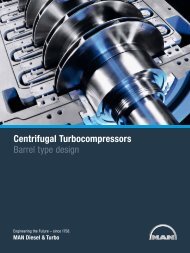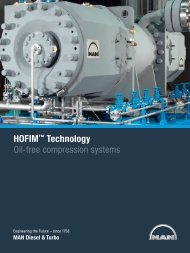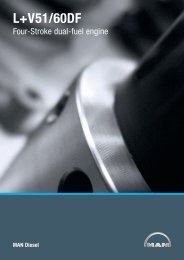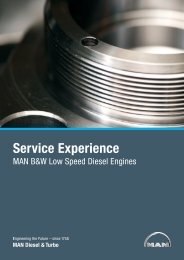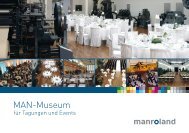MAN Museum - MAN Diesel & Turbo - 首页
MAN Museum - MAN Diesel & Turbo - 首页
MAN Museum - MAN Diesel & Turbo - 首页
You also want an ePaper? Increase the reach of your titles
YUMPU automatically turns print PDFs into web optimized ePapers that Google loves.
ChARACTERs<br />
Carl August Reichenbach. Carl Buz. Heinrich von Buz. Rudolf <strong>Diesel</strong>.<br />
Carl August Reichenbach<br />
manufactured among other<br />
Rudolf <strong>Diesel</strong><br />
the first time in 1895, efficiency<br />
Reichenbach (1801 – 1883)<br />
together with his brother-in-law,<br />
Carl Buz, takes over Sander’sche<br />
Maschinen-Fabrik in Augsburg in<br />
1844 after being skilled for all<br />
categories of producing flatbed<br />
presses in the company of his<br />
uncle, Friedrich Gottlob Koenig<br />
(inventor of the flatbed press).<br />
Reichenbach manufactures a<br />
things in Augsburg. 1864 he<br />
assigns the company to his son<br />
Heinrich.<br />
Heinrich von Buz<br />
Buz (1833 – 1918) joins Maschinenfabrik<br />
Augsburg in 1857, which<br />
was co-founded by his father Carl<br />
as Reichenbach’sche Maschinenfabrik<br />
in 1844.<br />
<strong>Diesel</strong>, born in Paris in 1858 as son of<br />
German parents, learned about the<br />
poor efficiency of the steam engine<br />
during his studies at TU Munich.<br />
In 1880, <strong>Diesel</strong> becomes head of<br />
the French branch of Professor Carl<br />
von Linde’s refrigerating machine<br />
company and, on his own initiative,<br />
build an ammonia engine.<br />
From 1890 onwards, he manages<br />
being registered at 16.6 percent.<br />
Thanks to the support of Heinrich<br />
von Buz, the world’s first operational<br />
diesel engine (on display at<br />
the German <strong>Museum</strong> in Munich)<br />
is built at Maschinenfabrik Augsburg<br />
between 1896 and 1897:<br />
efficiency 26.2%, 18 hp, engine<br />
speed 154 rpm, fuel consumption<br />
238 g/hph. Following its commercial<br />
launch in 1898, the novel<br />
printing press of the latest design From 1864 to 1913 he leads the<br />
Linde’s engineering department “<strong>Diesel</strong> patent heat engine” still<br />
in Augsburg: the flatbed press company as solely responsible<br />
in Berlin. Further thought resulted has to clear several hurdles before<br />
with railway movement, delivered managing director and unites it<br />
in an idea for an efficient heat it fully met the expectations of<br />
in 1845. This was the signal for the with Maschinenbau-Actien-<br />
engine. In 1893, he grants the its operators. As from the turn of<br />
printing press construction of Gesell schaft Nürnberg in 1898.<br />
German patent no. 67 207 for the century, the diesel engine con-<br />
manroland AG.<br />
Being called the “Bismarck of the<br />
“Working method and design of quers the entire world. It is used in<br />
German engineering industry” he<br />
internal combustion engines”, stationary plants, from 1903 also<br />
Carl Buz<br />
supports the development of the<br />
and concludes a contract with for marine propulsion and even<br />
10<br />
Buz (1803 – 1870), since 1838<br />
involved in the construction of the<br />
railway Munich-Augsburg as<br />
officer, together with Reichenbach<br />
established the basics for the later<br />
<strong>MAN</strong> in 1844. Under his guidance<br />
steam boilers, steam engines,<br />
water turbines and pumps are<br />
diesel engine at <strong>MAN</strong> in decisive<br />
dimensions, besides constructing<br />
the first German rotary press and<br />
the first refrigerating machine of<br />
Linde in 1873 under his aegis.<br />
1907 he achieves the Knight’s<br />
cross of the Royal order of Merit of<br />
the Bavarian Crown being<br />
combined with life peerage.<br />
Maschinenfabrik Augsburg for the<br />
construction of an experimental<br />
engine. Working now entirely on<br />
a freelance basis, <strong>Diesel</strong> is able to<br />
spend all his time on the development<br />
and construction of his<br />
engine. Based on the test engine<br />
(figure page 21), the effective<br />
output is successfully verified for<br />
today, is still the most economic<br />
of all heat engines. Rudolf <strong>Diesel</strong><br />
lives to see only the first signs of<br />
the major impact his pioneering<br />
achievement was going to make.<br />
He is missing during a sea passage<br />
from Belgium to Great Britain in<br />
fall of 1913 and has since been<br />
presumed to be dead.<br />
11



